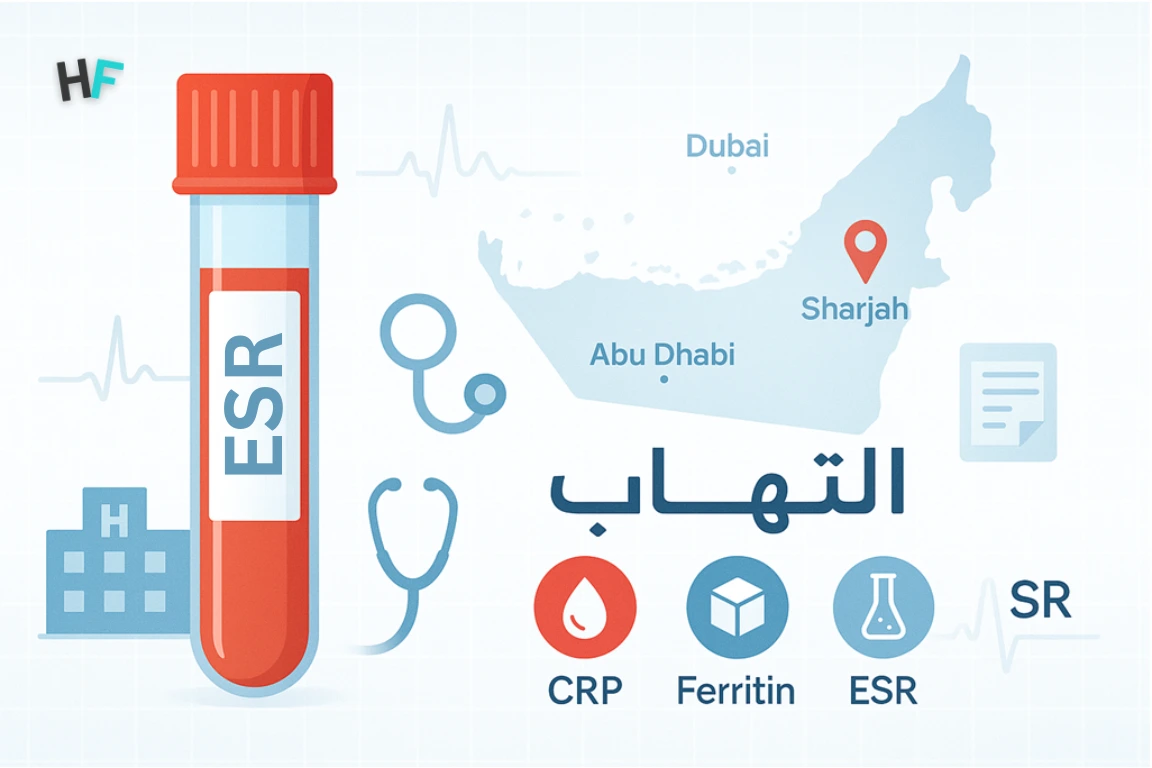Erythrocyte sedimentation rate (ESR) functions as a core, non-specific marker of systemic inflammation in UAE clinical settings. Contextual interpretation is required due to ESR’s delayed kinetics and variability across patient groups. Compared to C-reactive protein (CRP), ESR responds more slowly and often remains elevated after inflammation subsides. Baseline fluctuations are common in pregnant women, elderly individuals, and patients with anemia, complicating clinical assessment.
UAE clinical protocols integrate ESR analysis under the standards of DHA, MOHAP, and SEHA. Diagnostic interpretation relies on correlating ESR with CRP, serum ferritin, and albumin levels. Clinical decisions are guided by symptom-aligned differential diagnoses, criteria for specialist referrals, and supportive non-pharmacologic interventions.
This integrated framework enables UAE-based clinicians to identify benign versus pathological ESR elevations, particularly in diverse patient populations. Optimized diagnostic workflows help prioritize follow-up actions and reduce misinterpretation of ESR values.
Interpret Elevated ESR Values Using Multimodal Diagnostic Reasoning
Elevated ESR signals systemic inflammation but lacks disease specificity. In UAE hospitals, ESR interpretation requires context—especially in cases involving anemia, aging, or pregnancy, where baseline values may skew results.
DHA and SEHA guidelines promote a comparative biomarker approach. Clinicians triangulate ESR with CRP, ferritin, albumin, and clinical symptoms to improve diagnostic precision and minimize unnecessary referrals.
- High ESR + Low CRP may indicate systemic lupus erythematosus or multiple myeloma.
- High ESR + High CRP often points to infection or autoimmune activity.
Temporal trends in ESR, not just isolated readings, guide decisions—especially when symptoms are mild or absent.
In the UAE diagnostic ecosystem, ESR analysis aligns with structured protocols and payer models. Public systems (SEHA, DHA) and private labs (Aster, NMC, Mediclinic) offer serial testing, enabling longitudinal monitoring.
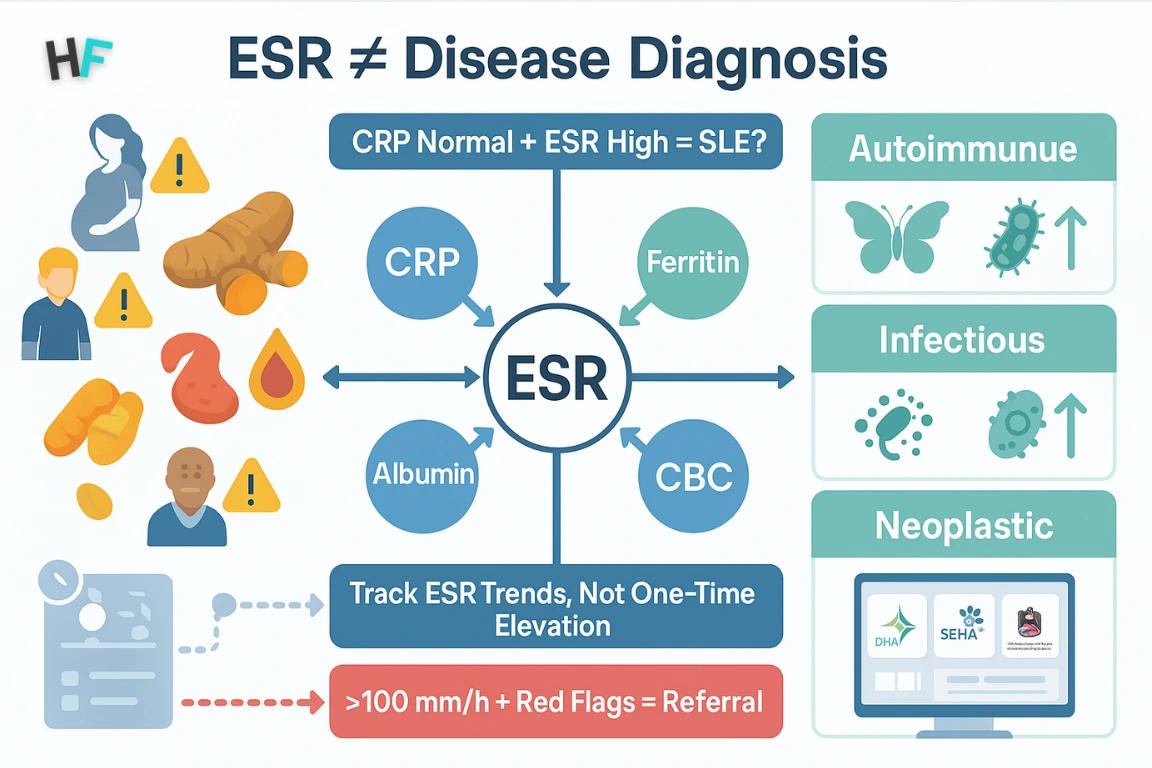
Best practice: Use ESR within a multi-marker diagnostic cluster, not as a standalone metric.
ESR as a Biomarker of Systemic Inflammation
Erythrocyte sedimentation rate (ESR) measures the settling rate of red blood cells in plasma, accelerated by fibrinogen and acute-phase proteins during inflammation. In UAE clinical practice, ESR is used to detect chronic or subacute inflammation but lacks disease specificity. It rises in autoimmune diseases, infections, malignancies, and benign states such as anemia and pregnancy.
To improve diagnostic precision, DHA and SEHA clinicians assess ESR trends alongside symptoms and complementary markers. Persistent elevation (>30 mm/h in women, >20 mm/h in men) without symptoms often triggers extended evaluation under UAE referral protocols.
ESR Elevation in Autoimmune, Infectious, and Neoplastic Conditions
The ESR trajectory—whether gradual, rapid, or extreme—helps clinicians in UAE hospitals narrow differential diagnoses across inflammatory, infectious, and oncologic domains.
| Condition Type | Common Diagnoses | ESR Pattern | UAE Clinical Note |
|---|---|---|---|
| Autoimmune | RA, SLE, Polymyalgia rheumatica | Gradual, sustained ↑ | ESR >50 mm/h typical in RA; CRP may remain normal in SLE |
| Infectious | TB, subacute endocarditis, osteomyelitis | Rapid, concurrent ↑ | ESR and CRP both rise; standard in DHA infectious disease workups |
| Neoplastic | Lymphoma, myeloma, solid tumors | Often very high (>100) | ESR >100 mm/h with normal CRP prompts oncologic evaluation |
ESR vs CRP vs Ferritin – Diagnostic Roles in Inflammation
ESR, CRP, and ferritin are interpreted as a diagnostic cluster in UAE hospitals, where each marker signals different phases of inflammation and guides lab-based clinical decisions.
| Marker | Function | Diagnostic Use | UAE Context |
|---|---|---|---|
| ESR | RBC aggregation via fibrinogen | Tracks chronic/subacute inflammation | Non-specific; interpreted with clinical correlation |
| CRP | Acute-phase hepatic reactant | Detects acute inflammation | Co-ordered with ESR in DHA/SEHA protocols |
| Ferritin | Iron storage + acute-phase reactant | Distinguishes anemia types | Elevated ferritin + ESR suggests inflammatory anemia |
In UAE hospitals, CRP is prioritized for acute infection screening, while ESR is monitored in autoimmune follow-ups. Ferritin helps determine whether elevated ESR reflects inflammation or iron dysregulation.
Preventing Diagnostic Error from False-Positive ESR Elevation
ESR is a broad inflammation marker but frequently yields false positives in non-inflammatory conditions. In the UAE, benign ESR elevations are common in elderly patients, pregnant women, and individuals with nutritional anemia.
Without context, these elevations may lead to unnecessary testing, increased insurance costs, and patient anxiety. To reduce diagnostic error, DHA and SEHA protocols prioritize contextual interpretation over rigid ESR thresholds.
Recognizing physiological elevations helps avoid over-investigation and supports efficient, cost-effective care.
How Do Age, Pregnancy, and Anemia Distort ESR Interpretation in UAE Labs?
Pregnancy, anemia, and aging each raise ESR through non-inflammatory mechanisms. UAE labs apply clinical filters—like using CRP in late pregnancy or adjusting ESR norms for age—to prevent false-positive referrals.
| Factor | ESR Impact | Mechanism | UAE Clinical Guidance |
|---|---|---|---|
| Pregnancy | Mild–moderate ↑ | Increased plasma volume, fibrinogen rise | Use CRP or ferritin in 3rd trimester evaluations |
| Anemia | Moderate ↑ | Lower RBC mass increases sedimentation | Always assess hemoglobin alongside ESR |
| Aging | Gradual ↑ with age | Chronic low-grade inflammation baseline | Apply age-adjusted thresholds (e.g., <30–40 mm/h) |
In UAE maternity and geriatric clinics, ESR adjustment is standard. CRP often replaces ESR in later stages of pregnancy to improve specificity.
ESR Elevated, CRP Normal, No Symptoms – What Does It Mean?
Isolated ESR elevation with normal CRP and no symptoms is a frequent clinical pattern in UAE primary care. Common non-acute causes include:
- Systemic lupus erythematosus (SLE) – CRP may remain normal despite active disease
- Monoclonal gammopathies – e.g., multiple myeloma
- Subclinical or resolving inflammation
Clinical Pathway in UAE Settings
When facing isolated ESR elevation:
- Reassess for subtle symptoms: fatigue, weight loss, localized pain
- Order supporting labs: CBC, ferritin, serum protein electrophoresis
- Defer imaging and referral unless:
- ESR >100 mm/h
- New or unexplained clinical findings
- High-risk indicators (e.g., cachexia, unexplained anemia)
DHA and SEHA protocols recommend a watchful waiting approach for asymptomatic patients. Escalation is reserved for defined clinical triggers only.
ESR Testing Access Across UAE’s Public and Private Labs
In the UAE, ESR testing is available through both public healthcare systems—SEHA (Abu Dhabi), DHA (Dubai), and MOHAP (northern emirates)—and private diagnostic providers such as Aster, NMC, Mediclinic, and LifeDx. The Westergren method is the diagnostic standard across all facilities.
Turnaround time, cost, and insurance coverage vary by emirate, provider type, and plan tier. ESR is commonly ordered under DHA and MOHAP protocols for:
- Initial workup of fever or systemic inflammation
- Autoimmune screening panels
- Tuberculosis (TB) surveillance
Private labs generally offer walk-in access. Public labs require referrals—typically from GPs or internal medicine consultants.
Access is most efficient in Dubai and Abu Dhabi. Residents in Sharjah, Ras Al Khaimah, and Fujairah may face longer referral chains and restricted public lab availability.
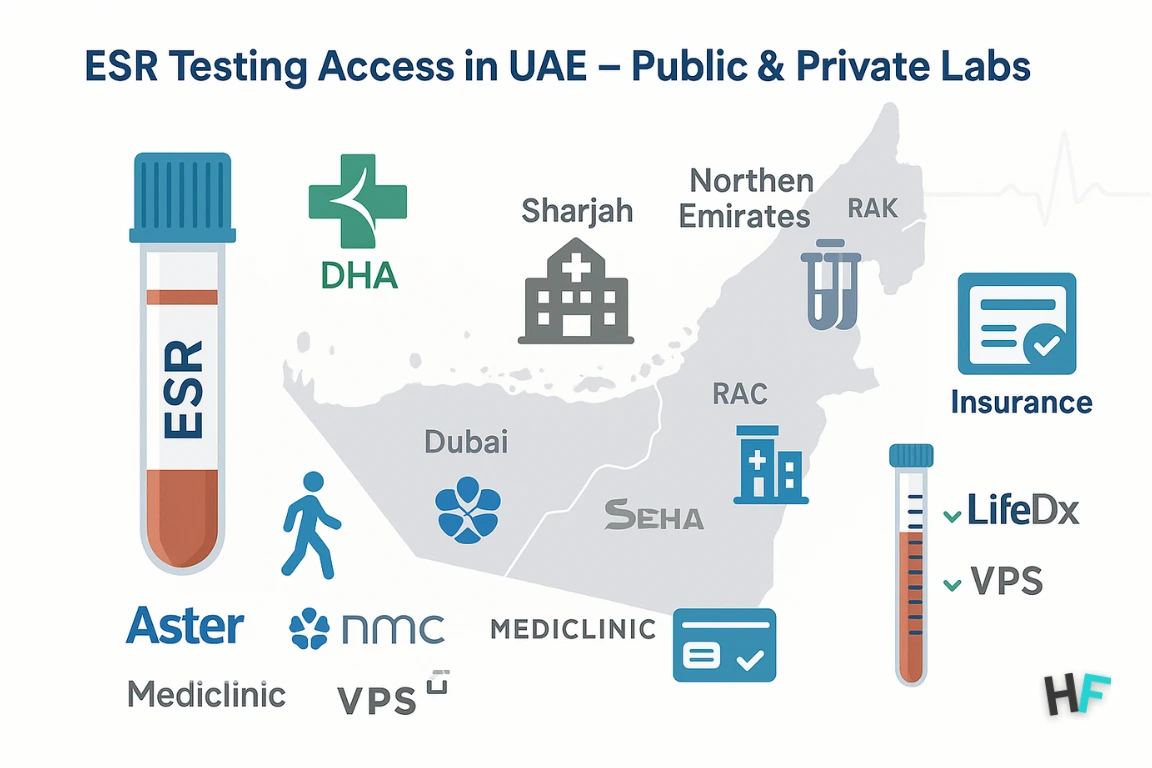
ESR Testing by Emirate and Provider Type
Access to ESR testing in the UAE varies by emirate, provider type, and insurance pathway. While private labs often offer walk-in flexibility, public sector testing—under DHA, SEHA, or MOHAP—requires referral-driven protocols and differs in turnaround times, bundling, and clinical scope.
| Emirate | Public Sector | Private Labs (Walk-In) | Access Notes |
|---|---|---|---|
| Dubai | DHA hospitals, clinics | Aster, Mediclinic, LifeDx | Fast turnaround; eReferral optional in select DHA facilities |
| Abu Dhabi | SEHA clinics, Mafraq, Tawam | VPS, NMC, Burjeel | ESR often bundled in autoimmune profiles |
| Sharjah | MOHAP clinics | Medcare, Al Borg | GP referral required for MOHAP access |
| Northern Emirates | MOHAP primary care | Aster, chain labs | Public lab access limited; dependent on insurance authorization |
ESR Re-Testing and Referral Protocols in UAE
UAE clinical guidelines emphasize trend-based ESR monitoring in conditions such as:
- Rheumatoid arthritis (RA)
- Systemic lupus erythematosus (SLE)
- Post-TB treatment follow-up
Insurance tier and provider protocol influence re-testing frequency and referral escalation.
| Clinical Scenario | Recommended Protocol |
|---|---|
| Stable RA or lupus | Re-test ESR every 4–6 weeks |
| ESR >100 mm/h + symptoms | SEHA permits direct specialist referral without primary physician review |
| DHA-managed referrals | SmartReferral system initiates re-test only if clinically justified |
UAE Referral Protocols for ESR-Based Escalation
Elevated ESR alone does not trigger specialist referral in the UAE. Referral eligibility depends on symptom correlation, ESR range, and insurer-authorized pathways integrated with EHR systems.
- DHA (Dubai) uses SmartReferral
- SEHA (Abu Dhabi) uses SEHACare
- Both platforms require clinical justification, based on protocols defined by DHA, SEHA, and MOHAP
When Referral Is Justified:
Referral is typically initiated when:
- ESR >50–70 mm/h + persistent symptoms
- ESR >100 mm/h + red-flag features, including:
- Unexplained weight loss
- Anemia
- Fever of unknown origin (FUO)
- Abnormal imaging findings
In rural Emirates (e.g., Fujairah, Umm Al Quwain), limited specialist access and manual routing may delay escalation.
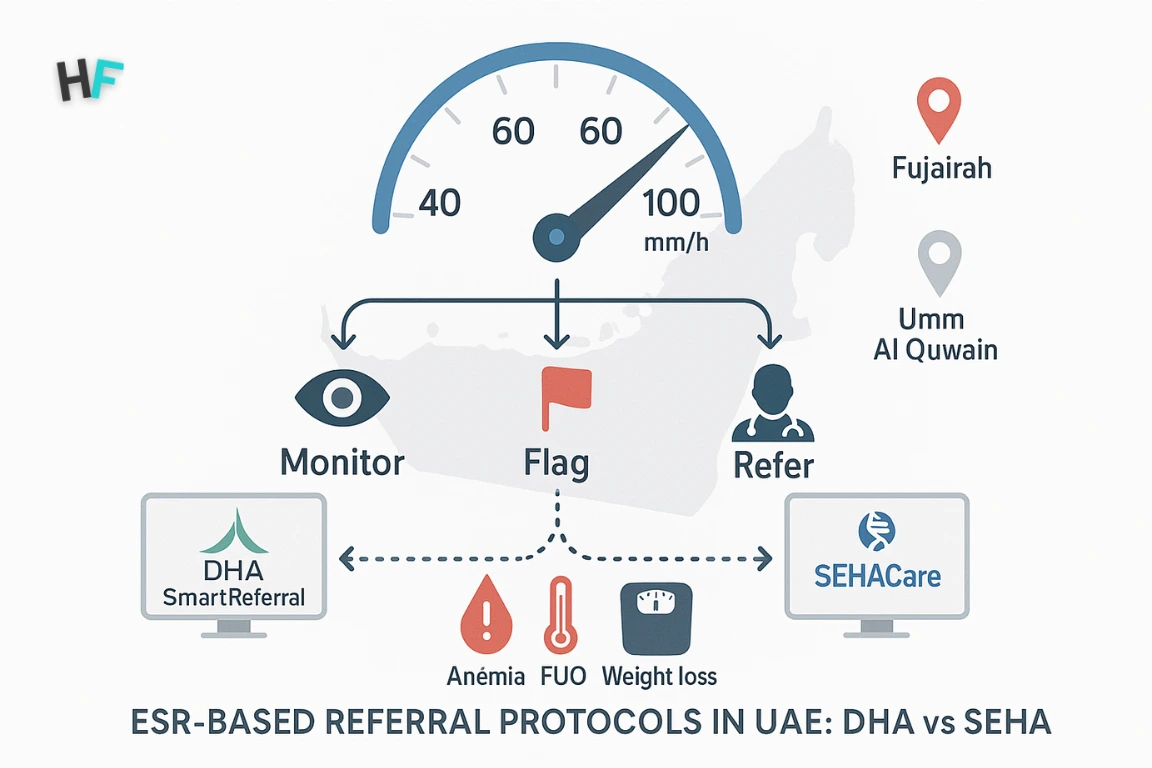
Referral Criteria by ESR Range and Clinical Presentation
In UAE clinical settings, referral escalation is determined not by ESR value alone, but by its interaction with symptom severity and duration. This table outlines the threshold-based decision flow used by DHA and SEHA—where SmartReferral and SEHACare protocols align specialist access with symptom-ESR clustering.
| ESR Range | Symptoms | Referral Action | UAE Protocol Note |
|---|---|---|---|
| 40–60 mm/h | Mild or absent | Monitor; no referral | Managed in primary care |
| 60–100 mm/h | Joint pain, low-grade fever | Refer if persistent | SmartReferral flags based on symptom duration |
| >100 mm/h | Anemia, weight loss, FUO | Direct specialist referral | SEHA allows fast-track to rheumatology/oncology |
DHA vs SEHA Referral Systems – Key Differences
Although both DHA and SEHA operate under EHR-integrated referral ecosystems, their escalation criteria, gatekeeper roles, and access logistics differ—particularly in how ESR thresholds and red-flag symptoms are processed across digital versus manual pathways.
| Protocol Element | DHA (Dubai) | SEHA (Abu Dhabi) |
|---|---|---|
| Referral Platform | SmartReferral (EHR-integrated) | SEHACare portal (EHR-integrated) |
| Gatekeeper Role | GP or Family Medicine | Internal Medicine or GP |
| Escalation Criteria | ESR + red-flag symptom cluster | ESR >100 mm/h with documented findings |
| Rural Access Challenges | Digital access varies by clinic | Manual delays in remote SEHA-linked regions |
Anti-Inflammatory Diets Aligned with UAE Clinical and Cultural Needs
In the UAE, anti-inflammatory diets are used to lower ESR by reducing systemic inflammation, correcting micronutrient deficiencies (e.g., vitamin D, iron, albumin), and modifying pro-inflammatory food habits. Dietary plans must respect halal standards, Ramadan fasting patterns, and local cuisine preferences.
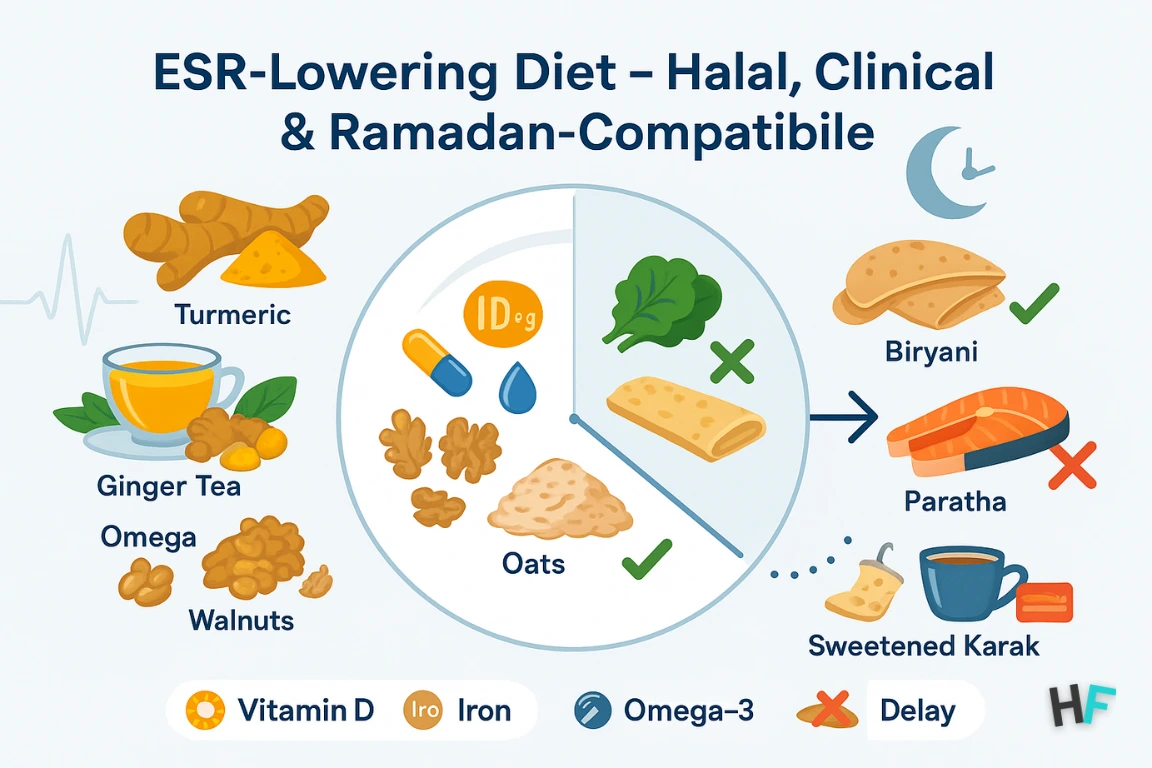
Clinically Recommended Foods in UAE Settings:
- Omega-3 sources: salmon, walnuts
- Spices: turmeric, ginger (used in curries and tea)
- Micronutrients: vitamin D, iron, folate (supplemented based on lab values)
- High-fiber foods: lentils, oats, leafy greens
DHA and SEHA clinics often replace high-glycemic staples like paratha, biryani, and sweetened karak chai with culturally familiar, lower-inflammatory alternatives.
Functional Foods and Their Anti-Inflammatory Mechanisms
Clinics adjust diets to maintain traditional flavors while replacing inflammatory ingredients with therapeutic alternatives.
| Food / Compound | Mechanism | UAE Clinical Use |
|---|---|---|
| Turmeric (Curcumin) | Inhibits NF-κB, lowers CRP | Common in curries; DHA-approved for dietary plans |
| Omega-3 (EPA/DHA) | Suppresses IL-6, reduces ESR | Found in salmon, walnuts; often prescribed as capsules |
| Ginger | Lowers TNF-α | Used in karak or broths |
| Fiber-rich grains | Modulate gut microbiota, reduce IL-1 | Lentils, oats integrated into Iftar meals |
| Vitamin D / Iron | Correct inflammatory anemia | Supplemented per Daman-approved lab thresholds |
Ramadan and Halal-Aligned Nutrition Strategies
In the UAE, anti-inflammatory dietary planning must align with cultural rhythms—especially during Ramadan. Clinicians adjust meal timing and nutrient load to lower systemic inflammation while respecting fasting patterns, halal compliance, and post-Iftar metabolic responses.
| Fasting Pattern | Effect on Inflammation | UAE Clinical Guidance |
|---|---|---|
| 16:8 fasting (Ramadan) | ↓ IL-6, ↓ CRP | Matches Ramadan; supports inflammation control |
| Suhoor (protein + fiber) | Stabilizes glucose, lowers cytokines | Recommend oats, eggs, yogurt pre-fast |
| Iftar high in sugar | ↑ IL-1, ↑ TNF-α | Replace sweets/juices with dates and broth-based soups |
UAE clinicians advise anti-inflammatory loading at Suhoor and limit fried/sugary foods at Iftar. Fish oil and curcumin supplements are scheduled outside fasting hours to maximize absorption and adherence.
Lifestyle Changes to Lower ESR in UAE Clinical Settings
Elevated ESR is often influenced by chronic stress, sleep loss, inactivity, and low hydration. In the UAE, these factors are targeted through structured interventions delivered across DHA, SEHA, and private-sector wellness programs, particularly in rheumatology, endocrinology, and preventive care.
Core Clinical Lifestyle Recommendations:
- Daily movement: ≥30 minutes of walking or low-impact activity
- Hydration: ≥2 L/day, adjusted for UAE heat and humidity
- Stress reduction: mindfulness, prayer, or CBT-based apps
- Sleep optimization: ≥7 hours/night, with routine reinforcement
Lifestyle coaching is offered via mobile apps and clinic-based programs, especially for patients with chronic inflammatory conditions where ESR trends are monitored over time.
Key Lifestyle Drivers of Systemic Inflammation
Behavioral risk factors such as poor sleep, dehydration, inactivity, and stress are potent modulators of systemic inflammation—amplifying ESR and cytokine levels over time. UAE-based care models address these through multidisciplinary clinics, digital tools, and culturally attuned interventions.
| Factor | Mechanism | UAE Clinical Integration |
|---|---|---|
| Sleep <6 hrs | ↑ IL-6, ↑ TNF-α | Addressed in SEHA sleep units, Mediclinic City sleep programs |
| Low hydration | ↑ blood viscosity | Managed via hydration counseling in DHA, Aster, and private clinics |
| Inactivity | ↑ CRP, ↓ antioxidant enzymes | DHA movement tracks in prediabetes and metabolic care |
| Chronic stress | ↑ cortisol, ↑ IL-1β | Guided dhikr, prayer, CBT apps used in integrated care models |
Use Digital Tools and Coaching for Long-Term Adherence
Sustained ESR reduction depends not just on clinical advice, but on consistent lifestyle adherence. UAE healthcare systems increasingly rely on health apps, WhatsApp groups, and coaching clinics to track inflammatory metrics, reinforce behavior change, and bridge the gap between lab results and real-world habits.
| Tool Type | Function | UAE Deployment |
|---|---|---|
| Health apps | Track sleep, hydration, activity | MySEHA, Apple Health, Fitbit integrations |
| WhatsApp groups | Peer support and habit reminders | Managed by DHA, Aster health educators |
| Coaching clinics | Behavior change + ESR trend tracking | Emirates Hospital, SEHA preventive care, Aster Wellness |
Apps and communication tools are available in Arabic, Urdu, Tagalog, and English, improving compliance across UAE’s diverse population.
Medications and Supplements for ESR Reduction in UAE Care Settings
When ESR remains elevated despite lifestyle or dietary changes, UAE clinicians escalate care using prescription medications or monitored supplements, guided by:
- Diagnosis (e.g., autoimmune disease, infection, metabolic syndrome)
- Lab trends (ESR, CRP, ferritin, 25(OH)D)
- Insurance authorization (Daman, Thiqa, or private providers)
Prescriptions follow DHA and SEHA protocols and may require specialist input.
Common Interventions:
- NSAIDs (e.g., naproxen): for mild inflammation and joint pain
- Corticosteroids (e.g., prednisone): for autoimmune flares
- Statins: when ESR elevation correlates with lipid abnormalities
- DMARDs/Biologics: for confirmed diagnoses like RA or SLE
- Supplements: curcumin, fish oil, vitamin D — prescribed with monitoring
Short-Term ESR Control With NSAIDs, Statins, or Corticosteroids
When lifestyle and dietary interventions fall short, clinicians in UAE settings may initiate pharmacologic strategies to reduce ESR—tailored to symptom severity, comorbidity, and insurance eligibility. This table outlines how NSAIDs, corticosteroids, and statins function mechanistically and how they’re deployed under DHA and SEHA protocols.
| Medication Class | Mechanism | Indication | UAE Practice |
|---|---|---|---|
| NSAIDs | COX-1/2 inhibition → ↓ PGE2 | Mild joint pain, low ESR | OTC or GP-prescribed in DHA/SEHA settings |
| Corticosteroids | ↓ IL-1, IL-6, TNF-α | Autoimmune flare | Requires consultant approval via DHA/SEHA protocols |
| Statins | ↓ IL-6, ↓ CRP | ESR elevation + dyslipidemia | Often initiated after lipid panel + risk assessment |
These are typically used short term during diagnostic staging or while awaiting lab confirmation before initiating DMARDs or biologics.
Supplement Use Under Pharmacovigilance Protocols
While natural supplements like curcumin, fish oil, and vitamin D offer anti-inflammatory benefits, their use in UAE clinical practice is regulated under pharmacovigilance protocols—particularly when patients are elderly, on polypharmacy regimens, or at risk of metabolic complications. The table below outlines supplement-specific effects, risks, and monitoring rules under DHA, SEHA, and Daman oversight.
| Supplement | Target Effect | Risk Factor | UAE Monitoring Protocol |
|---|---|---|---|
| Curcumin | Inhibits NF-κB, IL-6 | Hepatic stress at high doses | DHA recommends ≤1 g/day; monitor liver enzymes in elderly |
| Fish oil | IL-1β modulation, ↓ triglycerides | Bleeding risk with anticoagulants | SEHA flags INR interactions; avoid with high-dose aspirin |
| Vitamin D | Immune modulation + bone health | Hypercalcemia, renal stress | Monitor 25(OH)D and serum calcium per Daman care thresholds |
Supplements are available OTC in UAE pharmacies and online, but should be prescribed and monitored, especially in polypharmacy contexts or with comorbidities.
Use ESR for Ongoing Monitoring in Chronic Disease Management
ESR is a key long-term marker for tracking disease activity, treatment response, and flare risk in conditions like SLE, RA, TB, and polymyalgia rheumatica. In UAE care pathways, ESR is interpreted with CRP, symptom scores, and lab panels to guide therapy adjustments.
DHA and SEHA guidelines recommend ESR testing every 4–8 weeks for stable patients, with frequency adjusted based on disease severity and medication changes.
Follow-up labs typically include CBC, ferritin, and albumin, and are covered under chronic care plans by insurers such as Daman, Thiqa, and private payers.
ESR in Monitoring Autoimmune and Infectious Diseases
In UAE chronic care workflows, ESR is not only a diagnostic tool but a longitudinal marker for treatment response, flare prediction, and relapse monitoring—especially in autoimmune conditions like SLE and RA, or infectious diseases like TB. The table below summarizes how ESR tracking is protocolized under DHA and SEHA systems.
| Condition | ESR Role | UAE Monitoring Pattern |
|---|---|---|
| SLE | Detects flare when CRP is low | DHA: ESR every 6–8 weeks |
| RA | Tracks ongoing inflammation | ESR + CRP every 4–6 weeks |
| Treated TB | Flags relapse or residual infection | Bundled in SEHA infectious disease panels |
| PMR / Temporal arteritis | Monitors steroid taper response | ESR guides taper protocol under consultant supervision |
UAE rheumatologists rely on serial ESR values to adjust immunosuppressants—especially when CRP remains normal but symptoms evolve.
ESR Test Frequency by Clinical Scenario in UAE Systems
ESR re-testing intervals in UAE healthcare are tailored to clinical context—balancing disease activity, treatment phase, and insurance approval. Whether tapering steroids, managing stable autoimmune disease, or monitoring relapse risk, frequency is aligned with DHA and SEHA digital workflows and payer policy structures.
| Clinical Scenario | Recommended Frequency | UAE Implementation |
|---|---|---|
| Stable autoimmune disease | Every 6–8 weeks | Covered under Daman/Thiqa chronic care panels |
| Steroid tapering | Every 2–4 weeks | Used to titrate dose; integrated into rheumatology care |
| Prior ESR elevation, no symptoms | Every 3 months | Frequency depends on insurance tier + documentation |
| Active symptoms or relapse risk | Monthly | Fast-tracked via DHA/SEHA e-approval |
In public hospitals, ESR tracking is embedded in EHR dashboards with automated reminders to support protocol adherence and timely test ordering. Digital flags assist clinicians in synchronizing ESR testing with medication reviews and follow-up consults.
Use Decision-Support Tools to Guide ESR-Related Choices in UAE Care
In the UAE, elevated ESR—especially without symptoms—can lead to patient confusion or anxiety. Because ESR is non-specific, clinicians must clearly explain its significance and guide whether to monitor, test further, or begin treatment.
To support shared decision-making, DHA, SEHA, and private hospitals use structured tools, including:
- Infographics for simplified ESR interpretation
- Translated handouts (Arabic, Urdu, Tagalog, Hindi)
- Consent checklists outlining risks, benefits, and treatment thresholds
- Digital platforms to view ESR trends from home
These tools are critical in managing autoimmune disease, post-TB recovery, and age-related inflammation, where ESR is used for long-term tracking.
Standardize Consent and Communication for ESR-Based Decisions
Informed decision-making around elevated ESR requires more than lab results—it demands patient-centered communication. UAE health systems now implement standardized consent tools, visual aids, and verbal scripts to clarify next steps, minimize anxiety, and ensure patient understanding across literacy levels.
| Tool | Purpose | UAE Clinical Use |
|---|---|---|
| Infographics | Visual aid for ESR meaning | Displayed in DHA rheumatology and family clinics |
| Risk–benefit checklists | Clarify treatment vs. delay options | Included in SEHA discharge packets |
| Verbal consent scripts | Non-technical ESR explanation | Used by trained nurses at NMC, Aster, and SEHA |
These tools reduce unnecessary escalation by aligning patient understanding with clinical urgency.
Integrate Digital and Multilingual Tools for ESR Monitoring
To close the loop between clinical data and patient understanding, UAE health systems deploy multilingual visual tools, structured scripts, and risk–benefit checklists that translate ESR findings into actionable, language-accessible decisions—especially in primary care and rheumatology settings.
| Tool | Purpose | UAE Clinical Use |
|---|---|---|
| Infographics | Visual aid for ESR meaning | Displayed in DHA rheumatology and family clinics |
| Risk–benefit checklists | Clarify treatment vs. delay options | Included in SEHA discharge packets |
| Verbal consent scripts | Non-technical ESR explanation | Used by trained nurses at NMC, Aster, and SEHA |
Combining digital platforms with clear language improves patient adherence, reduces misinterpretation, and prevents unnecessary referrals.
Triage Incidental ESR Elevations in UAE Screening Programs
In the UAE, incidental ESR elevations are common during Weqaya screenings, executive panels, and chronic disease monitoring (e.g., diabetes, cardiovascular risk). These elevations often occur without symptoms, prompting patient concern and potential over-testing.
DHA and SEHA protocols do not treat asymptomatic ESR elevation as diagnostic. Triage depends on:
- Symptom presence or progression
- Co-marker results: CRP, ferritin, albumin
- Patient risk factors: age, comorbidities
Care pathways guide clinicians to observe, retest, or investigate selectively, based on context.
ESR Handling in Routine UAE Screening Programs
In population-level screenings across the UAE—such as Weqaya, executive checkups, and diabetes monitoring—ESR is often included as part of chronic inflammation surveillance. However, its interpretation follows structured triage logic, with thresholds like ≥50 mm/h prompting further review only when aligned with clinical context.
| Program | ESR Included? | Triage Workflow |
|---|---|---|
| Weqaya (Abu Dhabi) | Yes | Reviewed with CBC, lipids, CRP; flagged if ≥50 mm/h |
| Diabetes Monitoring | Sometimes | May signal chronic inflammation; follow-up based on case review |
| Executive Health Panels | Yes | ESR >50 mm/h prompts review; no referral unless symptoms are present |
SEHA guidance: Do not escalate ESR <50 mm/h unless red-flag signs are present (e.g., weight loss, anemia, fatigue).
ESR Triage Logic to Avoid Unnecessary Escalation
Because ESR is a non-specific biomarker, UAE clinical systems apply triage algorithms to avoid over-investigation. These workflows consider ESR thresholds, symptom presence, and comorbidity context—minimizing false alarms and ensuring referrals are evidence-based and payer-approved.
| Scenario | Recommended Action | UAE Protocol |
|---|---|---|
| ESR 30–50 mm/h, no symptoms | Recheck in 3 months; add CRP + CBC | No referral needed |
| ESR >50 mm/h, no symptoms | Screen for subtle symptoms; check ferritin | Assess for anemia or low-grade inflammation |
| ESR >100 mm/h, no symptoms | Rule out malignancy or autoimmune disease | Refer to internal medicine or rheumatology |
| Elderly or diabetic patients | Correlate ESR with symptoms | ESR is less specific; symptom-driven triage |
Elevated ESR is a contextual marker—not a diagnosis—and must be interpreted within the broader clinical picture. In the UAE’s insurance-regulated, multicultural healthcare system, effective ESR management relies on multimodal interpretation that includes CRP, ferritin, and symptom correlation; clearly defined referral thresholds under DHA and SEHA protocols; and care plans tailored to local dietary norms, fasting practices, and lab precision. To reduce unnecessary escalation, clinicians integrate biomarker comparison, lifestyle and dietary adjustments, and evidence-based use of medications or supplements, all aligned with disease-specific re-testing schedules. Public and private labs support regular monitoring through accessible platforms regulated by Daman, Thiqa, and other payers.
Not all ESR elevations require immediate action—treatment decisions should align with lab trends, clinical presentation, and comorbidity risk. Supplements, while common, must be used with caution and monitored for interactions, particularly in elderly or multi-morbid patients. Clear patient communication, supported by multilingual tools and visual aids, ensures understanding and reduces anxiety. With protocol-based care and culturally responsive communication, UAE healthcare providers can replace reactive testing with informed decision-making, helping patients move from confusion to clarity.
FAQs on How to Lower ESR Levels in UAE
Dr. Aisha Rahman is a board-certified internal medicine specialist with over 12 years of clinical experience in chronic disease management and preventive healthcare. She has worked at leading hospitals across the UAE, helping patients manage conditions such as diabetes, hypertension, cardiovascular diseases, and metabolic disorders.
A strong advocate for preventive medicine, Dr. Rahman emphasizes early diagnosis, lifestyle modifications, and patient education to reduce chronic illness risks. She is an active member of the Emirates Medical Association and has contributed to health awareness programs and medical research initiatives. Her expertise has been featured in The National UAE, Gulf Health Magazine, and leading medical journals. As a keynote speaker at healthcare conferences, she shares insights on evidence-based treatments, patient-centered care, and advancements in internal medicine.
Dr. Omar Al-Farsi is a clinical nutritionist and medical researcher with over 15 years of experience in dietary science, metabolic disorders, and preventive healthcare. He has served as a senior consultant for UAE healthcare authorities and contributed to public health initiatives focused on nutrition education and disease prevention.
Dr. Al-Farsi has collaborated with leading hospitals, research institutions, and universities in the UAE, ensuring that health information is scientifically accurate and evidence-based. His research has been published in Gulf Medical Journal, Dubai Health Review, and WHO Nutrition Reports, making significant contributions to nutrition science and public health awareness.

